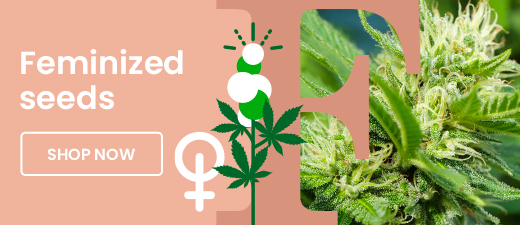Marijuana products
Feminized vs. Autoflower Seeds: Cultivate with Precision
Published
9 months agoon
By
admin
It all starts with selecting the right seed to grow. As one of the oldest plants ever cultivated by man, cannabis has survived centuries of history. Today, there are over 700 strains of cannabis developed through several years of plant study and in-breeding projects. However, all these strains belong to one of the three different types of cannabis seeds categories –regular, auto-flowering, and feminized. Therefore, your first decision as a new cannabis farmer will be to select the right type of seed for you. Making this decision requires a lot of consideration and comparison.
This review has compiled a guide explaining the different cannabis available today and why you should consider planting them.
1. Regular cannabis seeds
Regular cannabis seeds are the standard, non-engineered seeds. These seeds have equal chances of emerging into a female or a male cannabis plant. They are not optimized in any way or modified to influence the yield or character of the plant they develop into. Since they can produce male cannabis plants, regular seeds are popular among cannabis farmers who develop new cannabis strains. Pollen produced from the male seeds fertilizes a predetermined female flower, giving birth to a new generation of seeds.
With regular seeds, anything goes. The plant yield and character may be very different across a similar family. They can also exist as Indica-dominant types, Sativa-Dominant types, or in high CBD and high THC variants. The regular cannabis seed has genetics traced back to landrace ancestors first cultivated in the mountains of India to the beaches of Jamaica. Many experienced cannabis farmers have also attempted to get improved regular strains from two other regular strains. When these attempts succeed, the new strain expresses the qualities of the parent strains.
Compatibility profile
Do you think regular cannabis seeds will be perfect for your planting operation? It all depends on what you want. If you desire to have a farm full of both male and female cannabis seeds, then planting regular cannabis seeds is your best bet. With your garden full of both sexes, you can experiment and create your strains. But, of course, farming cannabis doesn’t have to be boring, even for a novice.
Combining these plants can give you customized varieties with unique traits. You can then proceed to develop only the strain with the trait you desire. Many commercial cannabis formers take cuttings from their plant. Suppose your plan to do this; growing out regular cannabis seeds is also your best bet. By cloning your plants, you skip the germination phase to produce fully viable clones of your regular cannabis plant. You might require help with this, though.
Should you plant regular cannabis seeds?
There exist no definite answers to this single question. It all depends on your target for planting the seeds and their compatibility with your planting operation. One of the biggest advantages of planting regular cannabis seeds is that you can produce many strains without specialized experience in cannabis farming. The processes involved in regular cannabis seeds cultivation are relatively compared with feminized and auto-flowering seeds. Since there is also an equal chance of producing both male and female plants, you can have a large repository of different strains, with both modern and classic genetics on the same piece of land. Ever heard of a pollen bank? You can also create one using your male plant population.
As you might expect, there are also many cons to growing regular seeds. These include misidentifying the sexes. The planting operation can also be very unpredictable as your seeds do not carry any genetic engineering to help through the different growth stages. The yield ratio and plant output rate can also be very unpredictable. You might also have to construct separate grow tents for both sexes. The accidental addition of a male plant in the female grow room might result in fertilization of the female flowers.
2. Feminized cannabis seeds
As the name suggests, feminized cannabis seeds were created to increase the chances of growing only females. By planting feminized seeds, you get a female plant 99.9 percent of the time. The possibility of germinating a male plant is almost eliminated. That means no pollen sacs but many flowers. To start with, feminized genetics is made by crossing one female plant with another. The fertilized female produces a generation of feminized seeds. How is that even possible? How can female cannabis plants produce pollen sacs needed to fertilize another female plant? The answer lies in plant genetic engineering.
To force a female plant to produce pollen, breeders use many methods. One involves stopping the production of ethylene in the plant tissues, forcing the female plant to produce pollen sacs. Various chemical agents, including colloidal silver, are used as catalysts for the process. Occasionally, female plants can also flip, relying on nature’s undying desire to procreate and produce oddly-shaped pollen sacs.
Compatibility profile
Although genetically engineered, feminized seeds also require adequate care during the different stages of growth. So, you need to learn a few proven growth strategies to help you through the growing stages. You should know that female cannabis plants prevented from fertilization will also produce flowers without seeds. Many marijuana users prefer a seedless cannabis flower.
If you prefer to see flowers on your cannabis plant and not pollen sacs, then feminized cannabis seeds are for you. Many farmers commercially grow cannabis strains for their flowers too. If you like to grow cannabis as a hobby, feminized seeds will help you save time too. You will save yourself the energy and time needed to sift males out of your growing space.
Why should you grow feminized cannabis seeds?
For starters, the equal chance of producing both sexes as with regular seeds is eliminated. You are guaranteed a grow room full of genetically engineered female cannabis plants. In addition to being cost-effective, you will also get big resinous buds and save time on many tendering processes. However, it is not always exactly smooth for farmers to plant only feminized seeds. Although the yield and output can be predictable, the plants can sometimes into hermaphrodites as a result of bad genetics or environmental stress. Feminized plants are also not suitable for breeding purposes. You get less viable clones, so in most cases, you can only start from the seed.
3. Autoflower cannabis seeds
These types of cannabis seeds can automatically transition into the flowering stage without any changes to their light cycle. Compared to other cannabis seeds, auto-flower seeds can properly move from germination to harvest with little or no external assistance. They are easy to grow, tend, and do not require the same level of complexity as regular or feminized seeds. Auto-flowering cannabis seeds are produced by using Cannabis ruderalis genetics.
This subspecies has the auto-flowering trait and adapt perfectly to the shorter growing seasons and extreme weather conditions of Central Asia and Russia. Instead of waiting on a change in light exposure to flowers, plants with the ruderalis genetics simply depend on age and time. Breeders find it exciting to work with auto-flowering strains, combining these genetics with other subspecies to create a new generation with desired qualities.
Compatibility profile
Auto-flowering seeds grow within a short period, making it possible to harvest a cache of cannabis in a very short time. If you are experimenting with cannabis cultivation and don’t mind spending extra cash on getting seeds, then auto-flowering seeds are made for you. You can set up a grow room in no time and take down your growing operation within a small window. If you only have a small growing space, auto-flowering seeds produce a short plant that fits right into small enclosures. This explains why discreet cannabis farmers choose to plant auto-flowering seeds. They grow fast into short plants and can be concealed outdoors with other regular plants.
Why should you grow auto-flowering cannabis seeds?
There are many reasons you should consider growing auto-flowering seeds. They are compact, require little space, and smoothly transition into the flowering stage. These qualities make auto-flowering seeds suitable for guerilla growing and beginner-friendly. In addition to all these, they are also higher in CBD. If you grow a room full of high CBD plants, you are sure to get more investment returns as they are heavily in demand for medical CBD. However, the auto-flowering plant produces less THC and is not as potent as other seeds. They are difficult to clone and can sometimes give a lower yield.
So, what do you think?
There are many pros and cons to growing the three types of cannabis seeds. You have to consider their compatibility profile and check if they fit right into your growing operations. You can get an improved yield on these seeds if you understand how to fertilize cannabis plants and the growth requirements needed. You can also check our seed bank for improved cannabis seeds that are easy to grow and give a high harvest yield.
*Amsterdam Marijuana Seeds encourages all customers to follow the laws set forth by their Country, State / Province, and local municipalities.
You may like
-


Is Cannabis Legal in California Right Now?
-


Germany: Trial against operator of Trier cannabis vending machine discontinued
-


The best energizing THC gummies of 2025 by Leafly
-


Mixed Messages From The Feds About Cannabis
-


Humboldt County extends deadline to pay marijuana cultivation taxes
-


How Hemp Helps You Sleep
General topics
Green Solution For Our Environment
Published
6 months agoon
October 8, 2024By
admin
With escalating environmental concerns, society’s search for sustainable, innovative solutions has never been more critical. One solution that shows great promise lies in the cultivation of an adaptable and versatile plant species known as industrial hemp. In this in-depth exploration, we will delve into the environmental benefits and the extraordinary potential of industrial hemp as an eco-friendly alternative across various industries.

I. The Background and Adaptive Nature of Industrial Hemp
Hemp, a variant of the Cannabis sativa plant species, boasts a history of usage dating back thousands of years due to its myriad applications. From ancient Chinese civilizations weaving hemp fibers into textiles to American colonists using it for paper and rope, the applications of this plant are as diverse as its history. Nevertheless, it is crucial to distinguish industrial hemp from marijuana – the former contains less than 0.3% THC, the psychoactive component in marijuana, making it unsuitable for recreational use.
Industrial hemp is a robust plant that makes it an environmentally sound choice for cultivation. It’s worth highlighting that it requires significantly less water than many traditional crops, including cotton. Hemp needs only about 20% of the water needed for cotton cultivation, offering a potential solution for regions prone to drought or with limited water resources. Furthermore, industrial hemp boasts a remarkable natural pest resistance, making it an ideal choice for organic farming and reducing the need for potentially harmful pesticides. This resistance not only lessens the strain on the environment but also allows for healthier soils and ecosystems, marking a significant stride in sustainable agriculture.
II. Industrial Hemp: A Carbon Sink and Soil Regenerator
Industrial hemp’s environmental impact extends far beyond water conservation and pest resistance. It exhibits impressive performance when it comes to absorbing carbon dioxide (CO2) from the atmosphere – an essential process known as carbon sequestration. Hemp absorbs more CO2 per hectare than many other crops and most trees, making it a formidable ally in our global fight against climate change.
Apart from its carbon sequestration potential, industrial hemp also contributes positively to soil health. Its deep root system helps to improve soil structure and prevent soil erosion, a critical factor in maintaining the health and sustainability of our agricultural systems. When the hemp plants decompose, they enrich the soil with nutrient-rich organic matter, enhancing its fertility for future crops. The impact of this cannot be overstated – by improving soil health, we can increase agricultural productivity and resilience, contributing to global food security and environmental protection.
III. Industrial Hemp’s Versatility Across Industries
The potential of industrial hemp extends far beyond agriculture and into various other industries:
A. Textiles
In the textile industry, the durability and strength of hemp fibers present a more sustainable and environmentally friendly alternative to synthetic fibers and cotton. Hemp can be used to create a vast array of textiles, from clothing to upholstery and even carpets. By switching to hemp-based textiles, we can significantly reduce our environmental impact and help build a more sustainable fashion industry.

B. Food Products
In the food sector, hemp seeds offer a nutrient-rich source of essential fatty acids, proteins, and vitamins. The potential of hemp seeds in contributing to our diets and promoting a sustainable food system is vast. They can be used in everything from baking to smoothies, offering a healthy, environmentally friendly alternative to many conventional food products.
C. Biofuels
In the energy sector, industrial hemp shows tremendous promise. It can be processed into biofuels like biodiesel and ethanol, which can reduce our reliance on fossil fuels and mitigate greenhouse gas emissions. As the world moves towards more sustainable energy sources, hemp-derived biofuels could play a significant role in this transition, offering a renewable, sustainable alternative to conventional fuels.
D. Building Materials
In the construction industry, industrial hemp is making its mark. It can be processed into several eco-friendly building materials like hempcrete – a composite material used in construction. These materials not only offer a sustainable alternative to traditional building materials, but they also have the added benefit of carbon sequestration. This means that not only are we reducing the environmental impact of the construction industry by using hemp-based materials, but we are actively removing CO2 from the atmosphere in the process.
Conclusion:
Industrial hemp stands out as an eco-friendly powerhouse with potential applications in numerous sectors. Its resilience, low resource requirements, carbon sequestration capability, and soil regeneration properties make it an environmentally beneficial crop. Furthermore, its versatility offers sustainable alternatives in industries such as textiles, food production, biofuel generation, and building construction. The cultivation and utilization of industrial hemp represent a significant step forward in our journey towards a more sustainable and eco-friendly future. By harnessing the power of this impressive plant, we can make strides towards environmental conservation and sustainable development in the face of increasing environmental challenges.
Frequently Asked Questions
What are the environmental benefits of industrial hemp?
Industrial hemp offers several environmental benefits, such as low water requirements, natural pest resistance, and carbon sequestration capabilities. It requires significantly less water than many traditional crops, making it suitable for regions prone to drought. The plant’s natural pest resistance reduces the need for harmful pesticides, promoting healthier soils and ecosystems. Moreover, industrial hemp absorbs more carbon dioxide per hectare than other crops, aiding in the fight against climate change.
What are the versatile applications of industrial hemp?
Industrial hemp has diverse applications across various industries. In textiles, it offers a sustainable and eco-friendly alternative to synthetic fibers and cotton, enabling the production of clothing, upholstery, and carpets. In the food sector, hemp seeds provide a nutrient-rich source for essential fatty acids, proteins, and vitamins, contributing to a sustainable food system. Industrial hemp can also be processed into biofuels like biodiesel and ethanol, reducing reliance on fossil fuels. Additionally, it can be used in eco-friendly building materials, such as hempcrete, for sustainable construction.
How does industrial hemp contribute to soil health and fertility?
Industrial hemp plays a crucial role in improving soil health and fertility. Its deep root system helps enhance soil structure and prevent erosion, ensuring the sustainability of agricultural systems. When hemp plants decompose, they enrich the soil with nutrient-rich organic matter, benefiting future crops. By improving soil health, industrial hemp contributes to increased agricultural productivity, resilience, and global food security while providing environmental protection.
absorbing carbon dioxide
Green Solution For Our Environment
Published
6 months agoon
September 21, 2024By
admin
With escalating environmental concerns, society’s search for sustainable, innovative solutions has never been more critical. One solution that shows great promise lies in the cultivation of an adaptable and versatile plant species known as industrial hemp. In this in-depth exploration, we will delve into the environmental benefits and the extraordinary potential of industrial hemp as an eco-friendly alternative across various industries.

I. The Background and Adaptive Nature of Industrial Hemp
Hemp, a variant of the Cannabis sativa plant species, boasts a history of usage dating back thousands of years due to its myriad applications. From ancient Chinese civilizations weaving hemp fibers into textiles to American colonists using it for paper and rope, the applications of this plant are as diverse as its history. Nevertheless, it is crucial to distinguish industrial hemp from marijuana – the former contains less than 0.3% THC, the psychoactive component in marijuana, making it unsuitable for recreational use.
Industrial hemp is a robust plant that makes it an environmentally sound choice for cultivation. It’s worth highlighting that it requires significantly less water than many traditional crops, including cotton. Hemp needs only about 20% of the water needed for cotton cultivation, offering a potential solution for regions prone to drought or with limited water resources. Furthermore, industrial hemp boasts a remarkable natural pest resistance, making it an ideal choice for organic farming and reducing the need for potentially harmful pesticides. This resistance not only lessens the strain on the environment but also allows for healthier soils and ecosystems, marking a significant stride in sustainable agriculture.
II. Industrial Hemp: A Carbon Sink and Soil Regenerator
Industrial hemp’s environmental impact extends far beyond water conservation and pest resistance. It exhibits impressive performance when it comes to absorbing carbon dioxide (CO2) from the atmosphere – an essential process known as carbon sequestration. Hemp absorbs more CO2 per hectare than many other crops and most trees, making it a formidable ally in our global fight against climate change.
Apart from its carbon sequestration potential, industrial hemp also contributes positively to soil health. Its deep root system helps to improve soil structure and prevent soil erosion, a critical factor in maintaining the health and sustainability of our agricultural systems. When the hemp plants decompose, they enrich the soil with nutrient-rich organic matter, enhancing its fertility for future crops. The impact of this cannot be overstated – by improving soil health, we can increase agricultural productivity and resilience, contributing to global food security and environmental protection.
III. Industrial Hemp’s Versatility Across Industries
The potential of industrial hemp extends far beyond agriculture and into various other industries:
A. Textiles
In the textile industry, the durability and strength of hemp fibers present a more sustainable and environmentally friendly alternative to synthetic fibers and cotton. Hemp can be used to create a vast array of textiles, from clothing to upholstery and even carpets. By switching to hemp-based textiles, we can significantly reduce our environmental impact and help build a more sustainable fashion industry.

B. Food Products
In the food sector, hemp seeds offer a nutrient-rich source of essential fatty acids, proteins, and vitamins. The potential of hemp seeds in contributing to our diets and promoting a sustainable food system is vast. They can be used in everything from baking to smoothies, offering a healthy, environmentally friendly alternative to many conventional food products.
C. Biofuels
In the energy sector, industrial hemp shows tremendous promise. It can be processed into biofuels like biodiesel and ethanol, which can reduce our reliance on fossil fuels and mitigate greenhouse gas emissions. As the world moves towards more sustainable energy sources, hemp-derived biofuels could play a significant role in this transition, offering a renewable, sustainable alternative to conventional fuels.
D. Building Materials
In the construction industry, industrial hemp is making its mark. It can be processed into several eco-friendly building materials like hempcrete – a composite material used in construction. These materials not only offer a sustainable alternative to traditional building materials, but they also have the added benefit of carbon sequestration. This means that not only are we reducing the environmental impact of the construction industry by using hemp-based materials, but we are actively removing CO2 from the atmosphere in the process.
Conclusion:
Industrial hemp stands out as an eco-friendly powerhouse with potential applications in numerous sectors. Its resilience, low resource requirements, carbon sequestration capability, and soil regeneration properties make it an environmentally beneficial crop. Furthermore, its versatility offers sustainable alternatives in industries such as textiles, food production, biofuel generation, and building construction. The cultivation and utilization of industrial hemp represent a significant step forward in our journey towards a more sustainable and eco-friendly future. By harnessing the power of this impressive plant, we can make strides towards environmental conservation and sustainable development in the face of increasing environmental challenges.
Frequently Asked Questions
What are the environmental benefits of industrial hemp?
Industrial hemp offers several environmental benefits, such as low water requirements, natural pest resistance, and carbon sequestration capabilities. It requires significantly less water than many traditional crops, making it suitable for regions prone to drought. The plant’s natural pest resistance reduces the need for harmful pesticides, promoting healthier soils and ecosystems. Moreover, industrial hemp absorbs more carbon dioxide per hectare than other crops, aiding in the fight against climate change.
What are the versatile applications of industrial hemp?
Industrial hemp has diverse applications across various industries. In textiles, it offers a sustainable and eco-friendly alternative to synthetic fibers and cotton, enabling the production of clothing, upholstery, and carpets. In the food sector, hemp seeds provide a nutrient-rich source for essential fatty acids, proteins, and vitamins, contributing to a sustainable food system. Industrial hemp can also be processed into biofuels like biodiesel and ethanol, reducing reliance on fossil fuels. Additionally, it can be used in eco-friendly building materials, such as hempcrete, for sustainable construction.
How does industrial hemp contribute to soil health and fertility?
Industrial hemp plays a crucial role in improving soil health and fertility. Its deep root system helps enhance soil structure and prevent erosion, ensuring the sustainability of agricultural systems. When hemp plants decompose, they enrich the soil with nutrient-rich organic matter, benefiting future crops. By improving soil health, industrial hemp contributes to increased agricultural productivity, resilience, and global food security while providing environmental protection.
General topics
A Green Solution For Our Environment And Industries
Published
6 months agoon
September 18, 2024By
admin
With escalating environmental concerns, society’s search for sustainable, innovative solutions has never been more critical. One solution that shows great promise lies in the cultivation of an adaptable and versatile plant species known as industrial hemp. In this in-depth exploration, we will delve into the environmental benefits and the extraordinary potential of industrial hemp as an eco-friendly alternative across various industries.

I. The Background and Adaptive Nature of Industrial Hemp
Hemp, a variant of the Cannabis sativa plant species, boasts a history of usage dating back thousands of years due to its myriad applications. From ancient Chinese civilizations weaving hemp fibers into textiles to American colonists using it for paper and rope, the applications of this plant are as diverse as its history. Nevertheless, it is crucial to distinguish industrial hemp from marijuana – the former contains less than 0.3% THC, the psychoactive component in marijuana, making it unsuitable for recreational use.
Industrial hemp is a robust plant that makes it an environmentally sound choice for cultivation. It’s worth highlighting that it requires significantly less water than many traditional crops, including cotton. Hemp needs only about 20% of the water needed for cotton cultivation, offering a potential solution for regions prone to drought or with limited water resources. Furthermore, industrial hemp boasts a remarkable natural pest resistance, making it an ideal choice for organic farming and reducing the need for potentially harmful pesticides. This resistance not only lessens the strain on the environment but also allows for healthier soils and ecosystems, marking a significant stride in sustainable agriculture.
II. Industrial Hemp: A Carbon Sink and Soil Regenerator
Industrial hemp’s environmental impact extends far beyond water conservation and pest resistance. It exhibits impressive performance when it comes to absorbing carbon dioxide (CO2) from the atmosphere – an essential process known as carbon sequestration. Hemp absorbs more CO2 per hectare than many other crops and most trees, making it a formidable ally in our global fight against climate change.
Apart from its carbon sequestration potential, industrial hemp also contributes positively to soil health. Its deep root system helps to improve soil structure and prevent soil erosion, a critical factor in maintaining the health and sustainability of our agricultural systems. When the hemp plants decompose, they enrich the soil with nutrient-rich organic matter, enhancing its fertility for future crops. The impact of this cannot be overstated – by improving soil health, we can increase agricultural productivity and resilience, contributing to global food security and environmental protection.
III. Industrial Hemp’s Versatility Across Industries
The potential of industrial hemp extends far beyond agriculture and into various other industries:
A. Textiles
In the textile industry, the durability and strength of hemp fibers present a more sustainable and environmentally friendly alternative to synthetic fibers and cotton. Hemp can be used to create a vast array of textiles, from clothing to upholstery and even carpets. By switching to hemp-based textiles, we can significantly reduce our environmental impact and help build a more sustainable fashion industry.

B. Food Products
In the food sector, hemp seeds offer a nutrient-rich source of essential fatty acids, proteins, and vitamins. The potential of hemp seeds in contributing to our diets and promoting a sustainable food system is vast. They can be used in everything from baking to smoothies, offering a healthy, environmentally friendly alternative to many conventional food products.
C. Biofuels
In the energy sector, industrial hemp shows tremendous promise. It can be processed into biofuels like biodiesel and ethanol, which can reduce our reliance on fossil fuels and mitigate greenhouse gas emissions. As the world moves towards more sustainable energy sources, hemp-derived biofuels could play a significant role in this transition, offering a renewable, sustainable alternative to conventional fuels.
D. Building Materials
In the construction industry, industrial hemp is making its mark. It can be processed into several eco-friendly building materials like hempcrete – a composite material used in construction. These materials not only offer a sustainable alternative to traditional building materials, but they also have the added benefit of carbon sequestration. This means that not only are we reducing the environmental impact of the construction industry by using hemp-based materials, but we are actively removing CO2 from the atmosphere in the process.
Conclusion:
Industrial hemp stands out as an eco-friendly powerhouse with potential applications in numerous sectors. Its resilience, low resource requirements, carbon sequestration capability, and soil regeneration properties make it an environmentally beneficial crop. Furthermore, its versatility offers sustainable alternatives in industries such as textiles, food production, biofuel generation, and building construction. The cultivation and utilization of industrial hemp represent a significant step forward in our journey towards a more sustainable and eco-friendly future. By harnessing the power of this impressive plant, we can make strides towards environmental conservation and sustainable development in the face of increasing environmental challenges.
Frequently Asked Questions
What are the environmental benefits of industrial hemp?
Industrial hemp offers several environmental benefits, such as low water requirements, natural pest resistance, and carbon sequestration capabilities. It requires significantly less water than many traditional crops, making it suitable for regions prone to drought. The plant’s natural pest resistance reduces the need for harmful pesticides, promoting healthier soils and ecosystems. Moreover, industrial hemp absorbs more carbon dioxide per hectare than other crops, aiding in the fight against climate change.
What are the versatile applications of industrial hemp?
Industrial hemp has diverse applications across various industries. In textiles, it offers a sustainable and eco-friendly alternative to synthetic fibers and cotton, enabling the production of clothing, upholstery, and carpets. In the food sector, hemp seeds provide a nutrient-rich source for essential fatty acids, proteins, and vitamins, contributing to a sustainable food system. Industrial hemp can also be processed into biofuels like biodiesel and ethanol, reducing reliance on fossil fuels. Additionally, it can be used in eco-friendly building materials, such as hempcrete, for sustainable construction.
How does industrial hemp contribute to soil health and fertility?
Industrial hemp plays a crucial role in improving soil health and fertility. Its deep root system helps enhance soil structure and prevent erosion, ensuring the sustainability of agricultural systems. When hemp plants decompose, they enrich the soil with nutrient-rich organic matter, benefiting future crops. By improving soil health, industrial hemp contributes to increased agricultural productivity, resilience, and global food security while providing environmental protection.

Is Cannabis Legal in California Right Now?

Germany: Trial against operator of Trier cannabis vending machine discontinued

The best energizing THC gummies of 2025 by Leafly

Mixed Messages From The Feds About Cannabis

Humboldt County extends deadline to pay marijuana cultivation taxes

How Hemp Helps You Sleep

420 in Texas is at Reggie & Dro

Daily Cannabis Use Can Help People Get Off Opioids (STUDY)

The Future of Cannabis and Sleep Medicine

This Wine Issue Is Becoming More Common

Distressed Cannabis Business Takeaways – Canna Law Blog™

United States: Alex Malyshev And Melinda Fellner Discuss The Intersection Of Tax And Cannabis In New Video Series – Part VI: Licensing (Video)

What you Need to Know

Drug Testing for Marijuana – The Joint Blog

NCIA Write About Their Equity Scholarship Program

It has been a wild news week – here’s how CBD and weed can help you relax

Cannabis, alcohol firm SNDL loses CA$372.4 million in 2022

A new April 20 cannabis contest includes a $40,000 purse

Your Go-To Source for Cannabis Logos and Designs

UArizona launches online cannabis compliance online course
Trending
-

 Cannabis News2 years ago
Cannabis News2 years agoDistressed Cannabis Business Takeaways – Canna Law Blog™
-

 One-Hit Wonders2 years ago
One-Hit Wonders2 years agoUnited States: Alex Malyshev And Melinda Fellner Discuss The Intersection Of Tax And Cannabis In New Video Series – Part VI: Licensing (Video)
-

 Cannabis 1012 years ago
Cannabis 1012 years agoWhat you Need to Know
-

 drug testing1 year ago
drug testing1 year agoDrug Testing for Marijuana – The Joint Blog
-

 Education2 years ago
Education2 years agoNCIA Write About Their Equity Scholarship Program
-

 Cannabis2 years ago
Cannabis2 years agoIt has been a wild news week – here’s how CBD and weed can help you relax
-

 Marijuana Business Daily2 years ago
Marijuana Business Daily2 years agoCannabis, alcohol firm SNDL loses CA$372.4 million in 2022
-

 California2 years ago
California2 years agoA new April 20 cannabis contest includes a $40,000 purse




